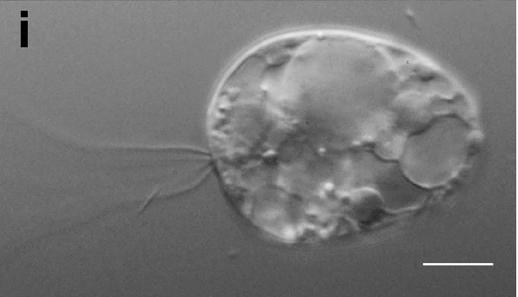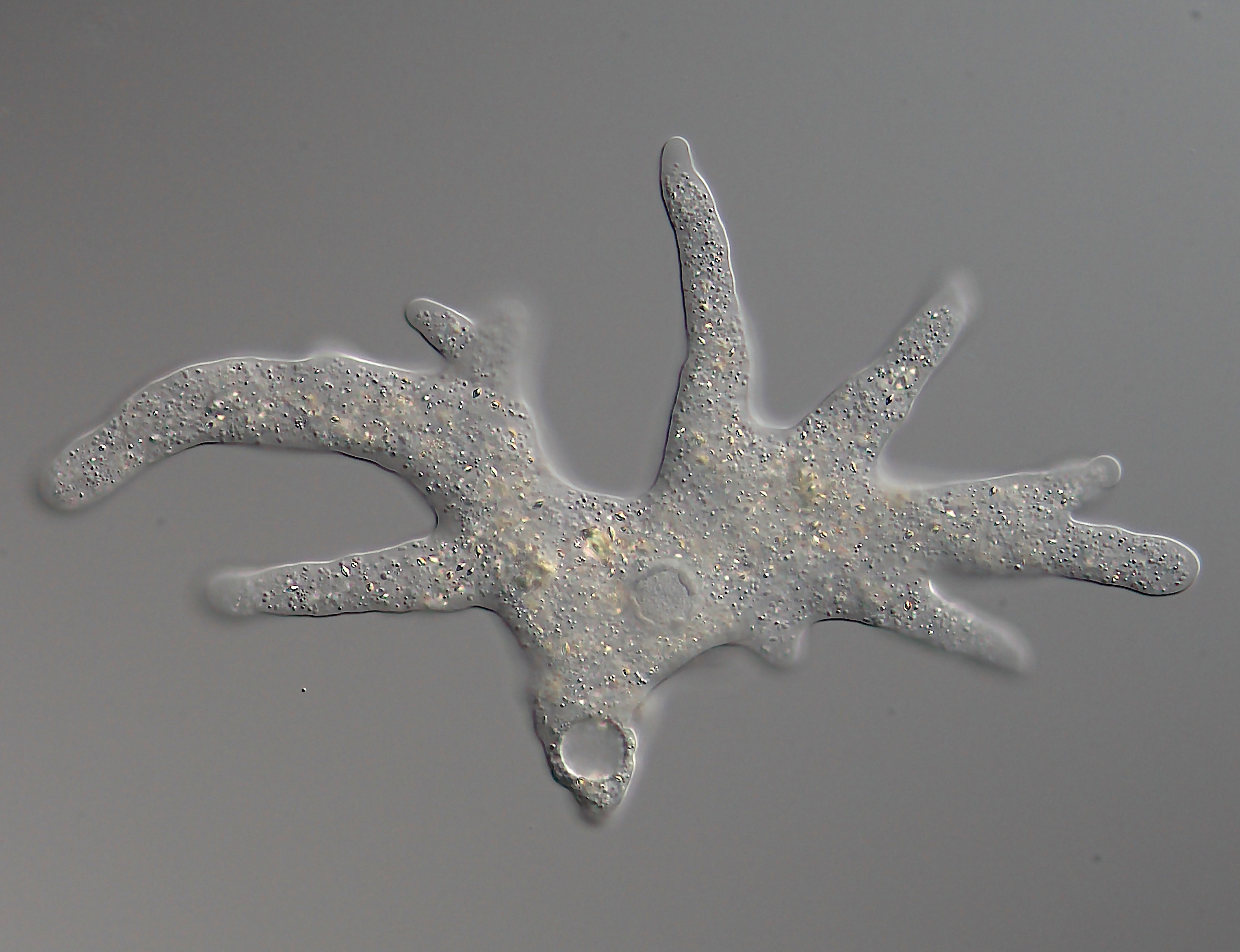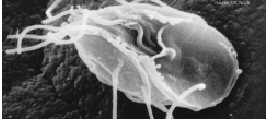|
Amorphea Orders
Amorphea is a taxonomic supergroup that includes the basal Amoebozoa and Obazoa. That latter contains the Opisthokonta, which includes the fungi, animals and the choanoflagellates. The taxonomic affinities of the members of this clade were originally described and proposed by Thomas Cavalier-Smith in 2002. The International Society of Protistologists, the recognised body for taxonomy of protozoa, recommended in 2012 that the term Unikont be changed to Amorphea because the name "Unikont" is based on a hypothesized synapomorphy that the ISOP authors and other scientists later rejected. It includes amoebozoa, opisthokonts, and apusomonads. Taxonomic revisions within this group Thomas Cavalier-Smith proposed two new phyla: Sulcozoa, which consists of the subphyla Apusozoa (Apusomonadida and Breviatea), and Varisulca, which includes the subphyla Diphyllatea, Discocelida, Mantamonadidae, Planomonadida and Rigifilida. Further work by Cavalier-Smith showed that Sulcozoa is para ... [...More Info...] [...Related Items...] OR: [Wikipedia] [Google] [Baidu] |
Ichthyosporea
The Ichthyosporea (or DRIP clade, or Mesomycetozoea) are a small group of Opisthokonta in Eukaryota (formerly protists), mostly parasites of fish and other animals. Significance They are not particularly distinctive morphologically, appearing in host tissues as enlarged spheres or ovals containing spores, and most were originally classified in various groups as fungi, protozoa, or colorless algae. However, they form a coherent group on molecular trees, closely related to both animals and fungi and so of interest to biologists studying their origins. In a 2008 study they emerge robustly as the sibling-group of the clade Filozoa, which includes the animals. Huldtgren et al., following x-ray tomography of microfossils of the Ediacaran The Ediacaran ( ) is a geological period of the Neoproterozoic geologic era, Era that spans 96 million years from the end of the Cryogenian Period at 635 Million years ago, Mya to the beginning of the Cambrian Period at 538.8 Mya. It is the las ... [...More Info...] [...Related Items...] OR: [Wikipedia] [Google] [Baidu] |
Choanoflagellate
Choanoflagellates are a group of free-living unicellular and colonial flagellate eukaryotes considered to be the closest living relatives of animals. The name refers to the characteristic funnel-shaped "collar" of interconnected microvilli and the presence of a flagellum. Choanoflagellates are found globally in aquatic environments, and they are of particular interest to evolutionary biologists studying the origins of multicellularity in animals. The flagellum of choanoflagellates is surrounded by microvilli at its base. Movement of the flagellum creates water currents that can propel free-swimming choanoflagellates through the water column and trap bacteria and detritus against the microvilli, where these foodstuffs are engulfed. This feeding plays an ecological role in the carbon cycle by linking different trophic levels. Choanoflagellates bear morphological similarities to the choanocyte, a type of cell in sponges. As the proposed sister group to Animalia, choanoflagellate ... [...More Info...] [...Related Items...] OR: [Wikipedia] [Google] [Baidu] |
Mantamonadidae
Mantamonads are a group of free-living heterotrophic flagellates that move primarily by gliding on surfaces (rather than swimming). They are classified as one genus ''Mantamonas'' in the monotypic family Mantamonadidae, order Mantamonadida, class Glissodiscea and phylum Mantamonadea.Guiry, M.D. & Guiry, G.M. 2025. ''AlgaeBase''. World-wide electronic publication, University of Galway. https://www.algaebase.org; searched on 12 June 2025. Previously, they were classified in Apusozoa as sister of the Apusomonadida on the basis of rRNA analyses. However, mantamonads are currently placed in CRuMs on the basis of phylogenomic analyses that identify their closest relatives as the Diphylleida and Rigifilida. Morphology ''Mantamonas'' are heterotrophic unicellular protists. Their cells are flattened, relatively plastic and asymmetric. They have one thin anterior flagellum and one conspicuous posterior flagellum, on which they glide. The cells have a right hump, likely caused ... [...More Info...] [...Related Items...] OR: [Wikipedia] [Google] [Baidu] |
Collodictyonidae
Collodictyonidae (also Diphylleidae) is a group of aquatic, unicellular eukaryotic organisms with two to four terminal flagella. They feed by phagocytosis, ingesting other unicellular organisms like algae and bacteria Bacteria (; : bacterium) are ubiquitous, mostly free-living organisms often consisting of one Cell (biology), biological cell. They constitute a large domain (biology), domain of Prokaryote, prokaryotic microorganisms. Typically a few micr .... Recent molecular analyses place collodictyonids (e.g. '' Collodictyon'') in a clade also containing Rigifilida and Mantamonadidae. This clade has been named CRuMs and is sister to Amorphea. Phylogeny Taxonomy * Class Diphyllatea Cavalier-Smith 2003 nisomonadea ; Diphyllatia Cavalier-Smith 2003** Order Diphylleida Cavalier-Smith 1993 ollodictyonida *** Family Sulcomonadidae Cavalier-Smith 2012 **** Genus '' Sulcomonas'' Brugerolle 2006 ***** Species '' S. lacustris'' Brugerolle 2006 *** Family Collodictyon ... [...More Info...] [...Related Items...] OR: [Wikipedia] [Google] [Baidu] |
Varisulca
Varisulca was a proposed basal Podiate taxon. It encompassed several lineages of heterotrophic protists, most notably the ancyromonads (planomonads), collodictyonids (diphylleids), rigifilids (''Rigifila'', ''Micronuclearia'') and mantamonads. Recent evidence suggests that the latter three are closely related to each other, forming a clade called CRuMs, but that this is unlikely to be specifically related to ancyromonads. Cavalier-Smith had proposed the new subphylum Varisulca which consists of the classes Hilomonadea, Diphyllatea and Glissodiscea. The validity of this proposed taxonomy has yet to ruled upon by the Society of Protistologists. It is unlikely to be widely accepted, since Varisulca appears to be paraphyletic or polyphyletic (ancyromonads are not inferred to be the sister group to CRuMs). Glissodiscea and Multirhiza (a taxon encompassing Diphyllatea and Glissodiscea) also appear paraphyletic or polyphyletic, since ''Mantamonas'' belongs to CRuMs but ancyromon ... [...More Info...] [...Related Items...] OR: [Wikipedia] [Google] [Baidu] |
Apusozoa
The Apusozoa are a paraphyletic phylum of flagellate eukaryotes. They are usually around 5–20 μm in size, and occur in soils and aquatic habitats, where they feed on bacteria. They are grouped together based on the presence of an organic shell or theca under the dorsal surface of the cell. The name derives from the Ancient Greek words for footless () and animal (). This phylum was defined as containing the Breviata and the Apusomonadida. However, it is viewed as paraphyletic, with the Breviata as more basal. The opisthokonts appear to have emerged as sister of the Apusomonadida. It has been suggested that the Mantamonadida be classified in Apusozoa. The Ancyromonadida appear to be Varisulca, Planomonadida, shifting them possibly more basal than the Amoebozoa, or less basal. While some classification systems have placed Hemimastigida in Apusozoa, 2018 research indicated that hemimastigotes (/Hemimastix/ Spironematellidae) are their own supra-kingdom. Characteristics The ... [...More Info...] [...Related Items...] OR: [Wikipedia] [Google] [Baidu] |
Sulcozoa
Podiates (Cavalier-Smith, 2012, excl. Ancyromonadida) are a proposed clade containing the Amorphea (incl. Opisthokonta, Amoebozoa, apusomonads and breviates) and the organisms now assigned to the clade CRuMs. Ancyromonadida does not appear to have emerged in this grouping. Sarcomastigota (Cavalier-Smith, 1983) is a proposed subkingdom (currently shown to be paraphyletic) that includes all the podiates that are ''not'' animals or fungi. Sulcozoa (Cavalier-Smith, 2012) is a proposed phylum (currently shown to be paraphyletic) within Sarcomastigota that does not include the phyla Amoebozoa (clade In biology, a clade (), also known as a Monophyly, monophyletic group or natural group, is a group of organisms that is composed of a common ancestor and all of its descendants. Clades are the fundamental unit of cladistics, a modern approach t ...) and Choanozoa (paraphyletic), i.e. it includes the proposed subphyla Apusozoa and Varisulca.. References {{Taxonbar, from=Q4 ... [...More Info...] [...Related Items...] OR: [Wikipedia] [Google] [Baidu] |
Apusomonadidae
The apusomonads (family Apusomonadidae) are a group of protozoan zooflagellates that glide on surfaces, and mostly consume prokaryotes. They are of particular evolutionary interest because they appear to be the sister group to the Opisthokonts, the clade that includes both animals and fungi. Together with the Breviatea, these form the Obazoa clade. Characteristics Apusomonads are small gliding heterotrophic biflagellates (i.e. with two flagella) that possess a proboscis, formed partly or entirely by the anterior flagellum surrounded by a membranous sleeve. There is a pellicle under the dorsal cell membrane that extends into the proboscis sleeve and into a skirt that covers the sides of the cell. Apusomonads present two different cell plans: *Derived cell plan, represented by '' Apusomonas'', with a round cell body and a mastigophore, a projection of the cell containing both basal bodies at its end. *"''Amastigomonas''-like" cell plan, with an oval or oblong cell that general ... [...More Info...] [...Related Items...] OR: [Wikipedia] [Google] [Baidu] |
Opisthokont
The opisthokonts () are a broad group of eukaryotes, including both the animal and fungus kingdoms. The opisthokonts, previously called the "Fungi/Metazoa group", are generally recognized as a clade. Opisthokonts together with Apusomonadida and Breviata comprise the larger clade Obazoa. Flagella and other characteristics A common characteristic of opisthokonts is that flagellate cells, such as the sperm of most animals and the spores of the chytrid fungi, propel themselves with a single ''posterior'' flagellum. It is this feature that gives the group its name. In contrast, flagellate cells in other eukaryote groups propel themselves with one or more ''anterior'' flagella. Flagellate cells however have been secondarily lost in some opisthokont groups, including most of the fungi. Opisthokont characteristics include synthesis of extracellular chitin in exoskeleton, cyst/spore wall, or cell wall of filamentous growth and hyphae; the extracellular digestion of substrates with os ... [...More Info...] [...Related Items...] OR: [Wikipedia] [Google] [Baidu] |
Amoebozoa
Amoebozoa is a major Taxonomy (biology), taxonomic group containing about 2,400 described species of Amoeba, amoeboid protists, often possessing blunt, fingerlike, Pseudopod#Morphology, lobose pseudopods and tubular mitochondrial cristae. In traditional classification schemes, Amoebozoa is usually ranked as a phylum within either the kingdom (biology), kingdom Protista or the kingdom Protozoa. In the classification favored by the International Society of Protistologists, it is retained as an unranked "supergroup (biology), supergroup" within Eukaryota. Molecular genetics, Molecular genetic analysis supports Amoebozoa as a monophyletic clade. Modern studies of eukaryotic phylogenetic trees identify it as the sister group to Opisthokonta, another major clade which contains both fungi and animals as well as several other clades comprising some 300 species of unicellular eukaryotes. Amoebozoa and Opisthokonta are sometimes grouped together in a high-level taxon, named Amorphea. Amoeboz ... [...More Info...] [...Related Items...] OR: [Wikipedia] [Google] [Baidu] |
Synapomorphy
In phylogenetics, an apomorphy (or derived trait) is a novel Phenotypic trait, character or character state that has evolution, evolved from its ancestral form (or Plesiomorphy and symplesiomorphy, plesiomorphy). A synapomorphy is an apomorphy shared by two or more taxon, taxa and is therefore Hypothesis#Scientific hypothesis, hypothesized to have evolved in their most recent common ancestor. ) In cladistics, synapomorphy implies Homology (biology), homology. Examples of apomorphy are the presence of Terrestrial locomotion#Posture, erect gait, fur, Evolution of mammalian auditory ossicles, the evolution of three middle ear bones, and mammary glands in mammals but not in other vertebrate animals such as amphibians or reptiles, which have retained their ancestral traits of a Terrestrial locomotion#Posture, sprawling gait and lack of fur. Thus, these derived traits are also synapomorphies of mammals in general as they are not shared by other vertebrate animals. Etymology The word ... [...More Info...] [...Related Items...] OR: [Wikipedia] [Google] [Baidu] |



